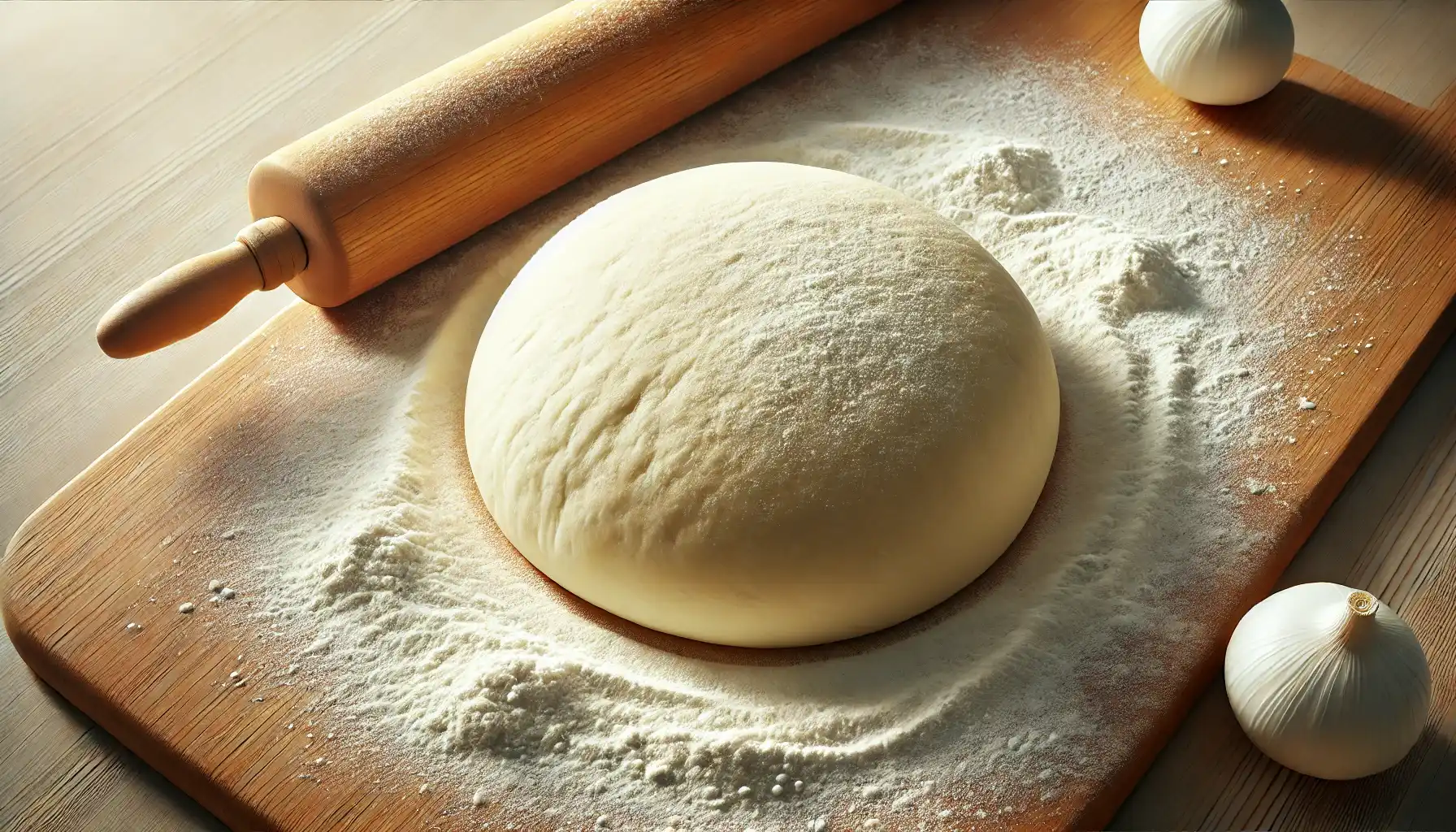Pizza Dough Recipe: Pizza is one of the most beloved dishes around the world, known for its crispy crust, delicious toppings, and the satisfying experience of a perfect slice. But what if I told you that the secret to an amazing pizza starts with its dough? While ordering a pizza may seem like the easiest route, making your own pizza dough at home can be a truly rewarding experience. With the right ingredients and technique, you can create a pizza crust that rivals your favorite pizzeria.
In this article, we will explore a simple and effective Pizza Dough Recipe, providing tips and insights that will help you master the art of making pizza dough. From understanding the role of each ingredient to perfecting the dough consistency, this guide has it all.
Why the Dough Matters
The dough is the backbone of any pizza, giving it structure, texture, and flavor. It’s not just a base for toppings; it’s a key element that determines how enjoyable your pizza will be. A well-made pizza dough should be slightly crispy on the outside while being soft and chewy inside. The balance of these textures is what separates a good pizza from a great one.
Ingredients Needed for Pizza Dough
Before we dive into the step-by-step instructions, let’s take a look at the essential ingredients needed for a basic pizza dough recipe:
- All-Purpose Flour or Bread Flour: 2½ cups (330g)
- Warm Water (around 110°F or 45°C): 1 cup (240ml)
- Active Dry Yeast: 2¼ teaspoons (one packet)
- Olive Oil: 2 tablespoons
- Sugar: 1 teaspoon (to help activate the yeast)
- Salt: 1 teaspoon
Step-by-Step Guide to Making Pizza Dough
- Activate the Yeast
- Begin by mixing the warm water, sugar, and active dry yeast in a small bowl. The water should be warm but not too hot, as high temperatures can kill the yeast. Stir the mixture gently and let it sit for 5-10 minutes until it becomes frothy. This indicates that the yeast is activated and ready to work its magic on the dough.
- Mix the Ingredients
- In a large mixing bowl, combine the flour and salt. Gradually pour in the yeast mixture and olive oil while stirring continuously. You can use a wooden spoon, but if you prefer, an electric mixer with a dough hook attachment works well too. Mix until the dough starts coming together.
- Knead the Dough
- Once the ingredients are combined, transfer the dough onto a lightly floured surface. Knead it with your hands for about 8-10 minutes. The goal is to achieve a smooth and elastic dough. If the dough feels too sticky, sprinkle a little extra flour as needed. Tip: Kneading is essential for developing gluten, which gives the dough its chewy texture. To check if your dough is ready, press it with your fingers—if it springs back slightly, you’re good to go!
- Let the Dough Rise
- Form the dough into a ball and place it in a lightly oiled bowl, turning it to coat with the oil. Cover the bowl with a clean cloth or plastic wrap and let it rise in a warm place for 1 to 1.5 hours or until it doubles in size. Tip: A warm, draft-free area is ideal for rising. If your kitchen is cold, you can preheat your oven to 150°F (65°C), turn it off, and let the dough rise in the residual warmth.
- Shape the Dough
- Once the dough has risen, punch it down to release the air. Transfer it to a floured surface and divide it into two equal portions if you’re making two smaller pizzas or keep it whole for one large pizza. Gently stretch or roll the dough into your desired pizza shape (round, square, etc.). Be careful not to press too hard, as it can deflate the air pockets that contribute to a light crust.
- Prepare for Baking
- Preheat your oven to 475°F (245°C) and place a pizza stone or an inverted baking sheet in the oven to heat. This step is crucial for achieving a crispy crust. Transfer the shaped dough onto a piece of parchment paper or a lightly floured pizza peel to make sliding it into the oven easier.
- Add Toppings and Bake
- Once the dough is shaped and ready, add your favorite pizza sauce, cheese, and toppings. Slide the pizza onto the preheated stone or baking sheet and bake for 10-12 minutes until the crust is golden and the cheese is bubbly and slightly browned. Tip: For an extra crispy crust, brush the edges of the dough with a little olive oil before baking.
Common Mistakes to Avoid When Making Pizza Dough
Even with the right recipe, it’s easy to make mistakes that can result in a dough that’s too tough, too dry, or not flavorful. Here are some common pitfalls to watch out for:
- Using Cold Water: Cold water won’t activate the yeast properly, leading to a dough that won’t rise well.
- Over-Kneading: Kneading too much can cause the dough to become tough and dense.
- Not Letting the Dough Rest: Allowing the dough to rest and rise is crucial. Rushing this step will lead to a chewy and flat crust.
- Ignoring the Preheat: Preheating your oven and pizza stone or sheet is essential for achieving the perfect crust.
Exploring Variations in Pizza Dough
Once you’ve mastered the basic pizza dough recipe, you can experiment with variations to suit your taste:
- Whole Wheat Pizza Dough: Replace half or all of the all-purpose flour with whole wheat flour for a healthier, nuttier crust.
- Herbed Pizza Dough: Add a teaspoon of dried herbs like oregano, basil, or rosemary to the dough for an extra layer of flavor.
- Garlic-Infused Dough: Mix minced garlic into the dough or brush the edges with garlic-infused olive oil before baking for a delightful aroma.
Understanding the Role of Each Ingredient
To truly appreciate the art of pizza dough making, it helps to understand what each ingredient contributes:
- Flour: The foundation of your dough. Bread flour, with its higher protein content, produces a chewier crust, while all-purpose flour yields a softer texture.
- Yeast: The leavening agent that makes the dough rise and creates those air pockets in the crust.
- Warm Water: Activates the yeast and hydrates the flour to form the dough.
- Olive Oil: Adds richness and helps create a tender crust.
- Sugar: Feeds the yeast and helps it activate faster.
- Salt: Balances the flavor and strengthens the gluten structure in the dough.
Storage and Freezing Tips for Pizza Dough
If you want to prepare dough in advance, it’s easy to store or freeze it for later use:
- Refrigerating: After the dough has risen, punch it down and place it in an airtight container. It can stay in the refrigerator for up to 3 days. Let it come to room temperature before shaping.
- Freezing: Divide the dough into portions, wrap them tightly in plastic wrap, and place them in a freezer-safe bag. It can be frozen for up to 3 months. When ready to use, thaw it in the refrigerator overnight and bring it to room temperature before shaping.
Final Thoughts
Making your own pizza dough at home may seem intimidating, but it’s actually quite simple with the right technique and understanding of the ingredients. By following this comprehensive guide, you can create a delicious pizza dough that forms the perfect base for any toppings you desire. The beauty of homemade pizza is that you have full control over the texture, flavor, and even the thickness of your crust.
With a bit of practice, you’ll be able to confidently make pizza dough that is crispy on the outside, soft on the inside, and full of flavor. So next time you’re craving a slice, skip the delivery and try making it yourself!




